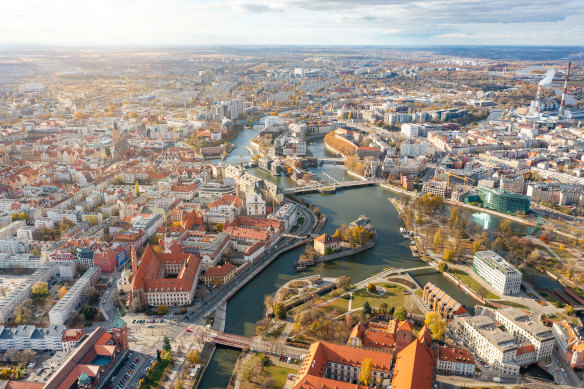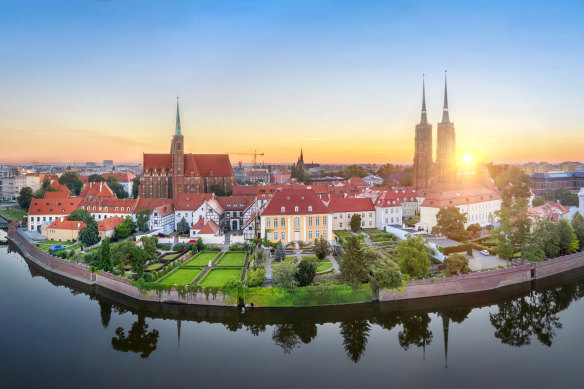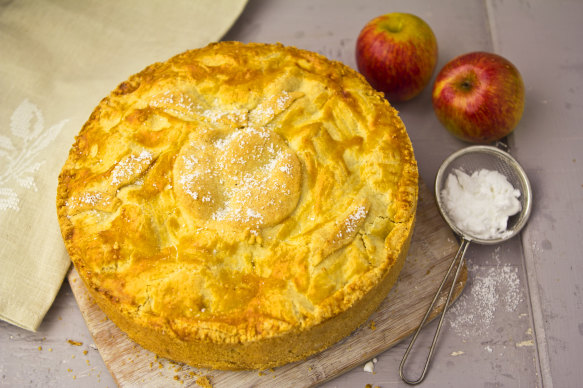This was published 1 year ago
Europe’s best undiscovered city (you probably can’t pronounce the name of)
My tongue can’t wrangle the jumble of consonants needed to pronounce the name of my favourite Polish city. In my mind, Wroclaw will always be Rock-law, although the Poles pronounce it Vrot-swav. We can’t even write it properly in English. The L should have a stroke through it, like the sign for British pounds. The Germans have given up, and call the city Breslau.
Wroclaw’s bamboozling name gives it a public-relations problem. Poland’s capital has its Anglicised form, Warsaw. The nation’s two other recognised cities Gdansk and Krakow are pronounced almost as they’re written. Easy to talk about, in short. Easy to book your budget flight to Krakow, which half of Europe does for their weekend break. Harder to travel to Wroclaw, because nobody understands where you want to go.

Wroclaw’s low profile defies explanation. Credit: iStock
Not that I have that problem, since I’m on a tour of Poland with Collette, and don’t have to worry about travel’s tedious practicalities. Just as well we’re here for a couple of nights, because Wroclaw is Poland’s most enjoyable destination.
This city’s low profile defies explanation. Wroclaw has a long history, was European Capital of Culture in 2016, and has an old town dense with Gothic architecture. Yet the city also features striking contemporary architecture, buzzes with commercial energy and has a rebellious, avant-garde attitude.
Our morning tour with Collette’s local guide Renata covers a thousand years of tribulations. Since its tenth-century founding Wroclaw has been Polish, Bohemian, Hungarian and Austrian. It was Prussian and German between 1742 and 1945, a long influence felt in its architecture and Brothers Grimm spires and gargoyles.
Ostrow Tumski or Cathedral Island – though island no longer – is where Wroclaw got its start. It has a monastic feel, cobbled and contemplative. Young priests in black robes flap across courtyards like Harry Potter extras. The cathedral is named for Jana Chrzciciela (John the Baptist) in another one of those improbable combinations of Polish letters that suggest a Scrabble player’s ultimate fantasy.
The multi-channelled Odra River carves the city into 12 islands and distinct districts stapled together by innumerable bridges. In later centuries, the town shifted across the river to erupt in colourful baroque buildings around a gigantic market square. Half of Wroclaw turns up in the square in the evenings to sit on café terraces or lounge on the artificial beach behind the Gothic town hall.

Ostrow Tumski or Cathedral Island is where Wroclaw got its start.Credit: iStock
The town is flamboyant with ecclesiastical excess. My wander is an encounter with Romanesque portals, Gothic spires and baroque cupids struggling with outrageous wardrobe malfunctions. Solny Square, the former salt market, is surrounded by cheerful orange and yellow buildings and now hosts the colourful flower market. Along the river is the bar-packed university district.
In other parts of Europe, a town this fine would be overrun by tour groups and stag parties. Its sumptuous architecture would be draped in racks of trinkets and souvenir T-shirts. Yet that evening as I head out to dinner, I’m surrounded by locals.

Apple pie, Polish-style.Credit: iStock
Polish cuisine is another exceedingly pleasant but largely unpronounceable surprise. Pasztecik szczecinski (deep-fried pie) and dziczyzna (game) aren’t words that trip off the foreigner’s tongue, even though they satisfy the palate. Taking up the linguistic challenge, I order the most garble-worthy dishes: barszcz czerwony (beetroot soup with dumplings) for starters, followed by pieczen wieprzowa (roast pork). Fortunately, waiters in Poland are used to the horrors inflicted upon their language by visitors. My server waiter winces, but the food arrives.
I finish with jablecznik, which turns out to be apple cake. The L has one of those horizontal strokes through it, like Wroclaw itself. Not actually an L at all, then, but worth getting your tongue around in any language.
Brian Johnston travelled as a guest of Collette.
THE DETAILS
MORE
FLY
Emirates flies from Sydney and Melbourne via Dubai to Warsaw, with onward domestic connections to Wroclaw. See emirates.com
TOUR
Collette’s 11-day country intensive “Discovering Poland” tour visits Wroclaw and numerous other cities such as Warsaw and Krakow, with multiple departures between May and December. From $3249pp twin share. Phone 1300 792 196. See gocollette.com
Sign up for the Traveller Deals newsletter
Get exclusive travel deals delivered straight to your inbox. Sign up now.